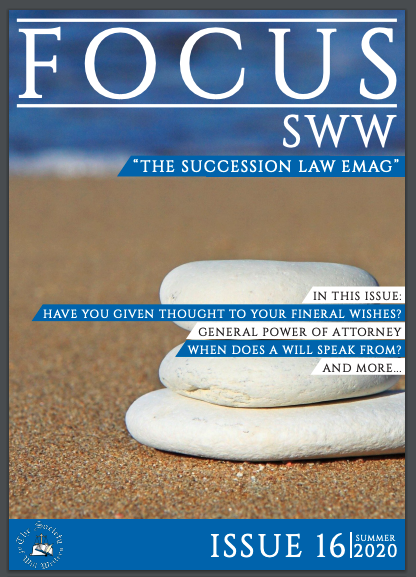
From The Will Company
Protective Property Trusts (PPTs) are one of the most used Trusts in Wills today. These Trusts are very helpful for clients who wish to allow a person (usually a spouse or partner) to live in their property whilst also offering protection over that property. What follows is an overview of what a PPT can be used for and what should be considered when advising on such a Trust.
A PPT gives a person known as the life tenant the right to live in the property (usually the testator’s main home). This is normally for the rest of the life tenant’s life, although certain other conditions might be included such as ending on a remarriage. If the life tenant wishes to move, the trustees have the power to sell the property and use the sale proceeds to purchase a substitute property for the life tenant to live in.
In addition to this, the life tenant is also entitled to all income generated by the Trust. In most cases whilst the life tenant is living in the home rent free, no income would be generated. However, income could be generated if they moved out and rented the property or alternatively where cash is released by downsizing.
The testator may also wish to include powers for the trustees to transfer Trust capital to the life tenant at their discretion. This could be useful where cash is released by downsizing, as the trustees could pass cash sums to the life tenant either outright or on a loan basis.
At the end of the Trust, the property can pass to named default beneficiaries of the Trust, this will usually be the testator’s children.
Why use a Protective Property Trust?
The most common use of a PPT is between spouses or civil partners is to ensure that their share in the home (which is normally their main asset) will pass to their children at the end of the Trust. Allowing the surviving spouse to inherit their share of the property outright could cause several problems.
If the survivor remarries, the house could be passed to their new spouse under a new Will/by intestacy or alternatively, if this new marriage ends in divorce, the house could form part of the divorce settlement. A PPT will ensure that the children (or other chosen beneficiaries) will inherit the deceased’s share.
A surviving spouse could be subject to long term care fees or bankruptcy in the future. If the deceased puts their share of the property into a PPT when they die, that share will be owned by the trust rather than the spouse outright and is therefore sheltered from the surviving spouse’s potential long term care fees or bankruptcy.
Where each spouse has children from previous relationships, the surviving spouse may amend their Will in the future and disinherit the deceased’s children. A PPT ringfences the deceased’s share of the property for their beneficiaries and can ensure that they cannot be removed as beneficiaries by the surviving spouse.
How is a Protective Property Trust Taxed?
A PPT will normally be treated as an Immediate Post Death Interest Trust and would be a Qualifying Interest in Possession Trust. For IHT purposes this would mean that the life tenant is treated as inheriting the Trust property. On the life tenant’s death, the assets in Trust are revalued and then taxed as part of the life tenant’s estate.
In most cases this will not cause any issues as the surviving spouse/civil partner will be the life tenant of the Trust and the spousal exemption shall apply. The property will only be assessed for IHT at the end of the Trust. Where the life tenant is not a spouse or civil partner (e.g., where a couple are unmarried), the spousal exemption will not apply, and the property will be assessed on the testator’s death as part of their estate and again as part of the life tenant’s estate on their death.
If clients are unmarried and are concerned about IHT it may not be advisable for a PPT to be included in their Wills and other options such as a Nil Rate Band Discretionary Trust could be considered.
Where a PPT ends earlier than death (for example if written to end on remarriage) the gift of the Trust capital to the default beneficiaries will be treated as a potentially exempt transfer from the life tenant’s estate for IHT purposes.
Residence Nil Rate Band should be available in most cases where the life tenant is a spouse/civil partner and the default beneficiaries named are descendants and inherit outright.
Could you do with some FREE, sound advice on:
- Writing a Will – What do I need and how much does it cost?
- Creating Lasting Powers of Attorney – If I was incapacitated who can act on my behalf?
- Property Protection Trusts – Can these really save Care Home Fees?
- Pre-Paid Funeral Plans – With so many to choose from how do I decide which plan is best?
There is so much confusion on these vital areas of estate planning, that sometimes just a chat with an expert in the field can clear up misunderstanding and set out the way ahead, without all the legal jargon.
Or complete the form below
Steve Worsfold
Affiliate Member of the Society of Will Writers
Advising on Wills/Trusts/Probate/Powers of Attorney

Mobile: 07734 744886
Office: 01903 533681
Email: steve@sussexwillwriters.co.uk
Website: www.sussexwillwriters.co.uk
Protecting What’s Precious to You,
Now and in the Future
Sussex Will Writers is proud to support Dementia Friends,
an initiative of The Alzheimers Society
Our business is certified ‘Safe to do business with’ and ‘Code compliant’
by the UK’s largest regulatory body for Will Writers, The Society of Will Writers.
Steve Worsfold has been an Affiliate Member of the Society for 15 years.
Sign Up to Receive our Free Newsletter
We send a Newsletter once a quarter and only occasional mailings to provide updates on changes in government policy or news of any special offers. You can download the latest version of our Newsletter by signing up with your name and email.

Sign Up to Receive our Free Newsletter
We send a Newsletter once a quarter and only occasional mailings to provide updates on changes in government policy or news of any special offers. You can download the latest version of our Newsletter by signing up with your name and email.





